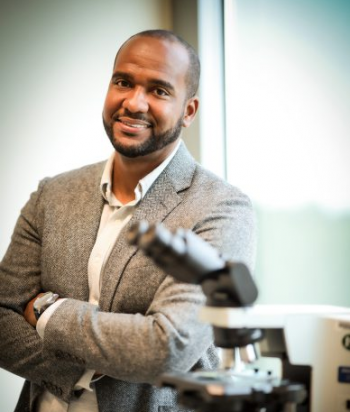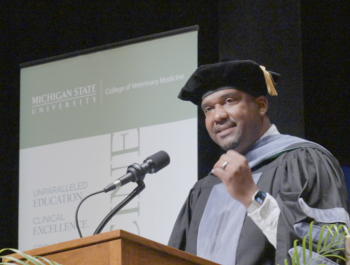With firsthand knowledge from the frontlines of biomedical research, this year’s commencement speaker brought a unique perspective shaped by his distinguished career in veterinary pathology.

Ian Moore, DVM, PhD, DACVP, earned his DVM degree from Tuskegee University before starting an anatomic pathology residency at MSU, which he completed while simultaneously pursuing a PhD through the National Institute of Health’s (NIH) Comparative Pathology program. He went on to spend 12 years at the NIH, eventually serving as section chief for the Infectious Disease Pathogenesis section and contributing to the pre-clinical testing of the Moderna COVID-19 vaccine. He now serves as director of the Pathology Division at the Emory National Primate Research Center.
What initially drew you to veterinary medicine? What about to veterinary pathology?
It was a combination of where I grew up and natural inclinations when it comes to science. I grew up in a rural area in Alabama, so I was always around animals and out in nature. I generated my own questions about how things work. It was very natural for me to pursue something in science, and veterinary medicine was a great culmination of physiology and anatomy—why things look and work the way they do. And then as I went deeper, I became interested in the dysfunction of those things, and that’s when I started getting into pathology. I am interested in how things work, and then when there is disease, why sometimes they don’t.
What do you remember most about your time at MSU?
First and foremost, I remember how cold I was when I first moved here! I was coming from Alabama, and I had never been in snow.
I remember the faculty at the Diagnostic Laboratory—those people were very instrumental in my training. It’s kind of intimidating coming up as a minority to a place where there aren’t a lot of people who look like you, but those people were some of the most welcoming I have ever met.
What were some of the challenges and rewards of working on the pre-clinical studies for the COVID-19 vaccine?
One of the biggest challenges was the size and scope of producing a vaccine that essentially everybody needed. It’s one thing to work on a project for something that seems distant, but it’s another thing to work on a project for people who are currently wearing masks at the grocery store and staying six feet apart. I’m there working to remedy those things. I was also working with a large pharmaceutical company that was trying to move fast. They’re used to moving fast, whereas government-related research is slower. Balancing between the speed they needed and the thoroughness we needed was challenging. The reward, I think, is self-explanatory. The reward is the fact that you and I are sitting across from each other, having a conversation in the same room without masks on. That would have sounded funny five years ago. Not now.
How do you envision the role of veterinarians evolving in the next decade, especially in the context of global health challenges?
Diseases don’t care about borders or state lines. With increased travel, there is a growing risk of disease spread, which means what veterinarians do is even more important. A lot of diseases that we talk about have animals as hosts or amplifying hosts, so I think it’s important that we have people who understand animals in their natural settings—their behaviors, their physiology. When they have outbreaks in certain places, they send teams of veterinarians to better understand what the disease could be and what the implications could be from a zoonotic standpoint. That role will only become more important as the spread of infectious threats continues to grow.
You’ve been recognized in the past by MSU for your efforts in diversity and inclusion. What drives your commitment to those areas?
I know that not many people who look like me are doing what I’m doing. I’ve found that I can be a bridge when it comes to helping underrepresented communities feel informed about the process of getting vaccinated. I want to help people understand how vaccines work and empower them to make the right choice for themselves and their families.

What message do you hope to convey with your commencement speech?
Everyone moves through their life in a direction. Let’s say that movement is in an ocean. As you move forward, you create waves. My questions are: Where do those waves go? Who do they impact? How do they come back? My message to students is to be mindful of the waves they make. If I move through life and I treat people with respect, I’m honest, and I try to be a good person, my waves will go out gently. Somebody else will get my wave and pass it on. But if I go through life in a speedboat, not caring who’s in my wake, those waves will come back with the same power and tip my boat over. You have to be mindful of who you are, how you navigate, and how you interact with those you pass by.
